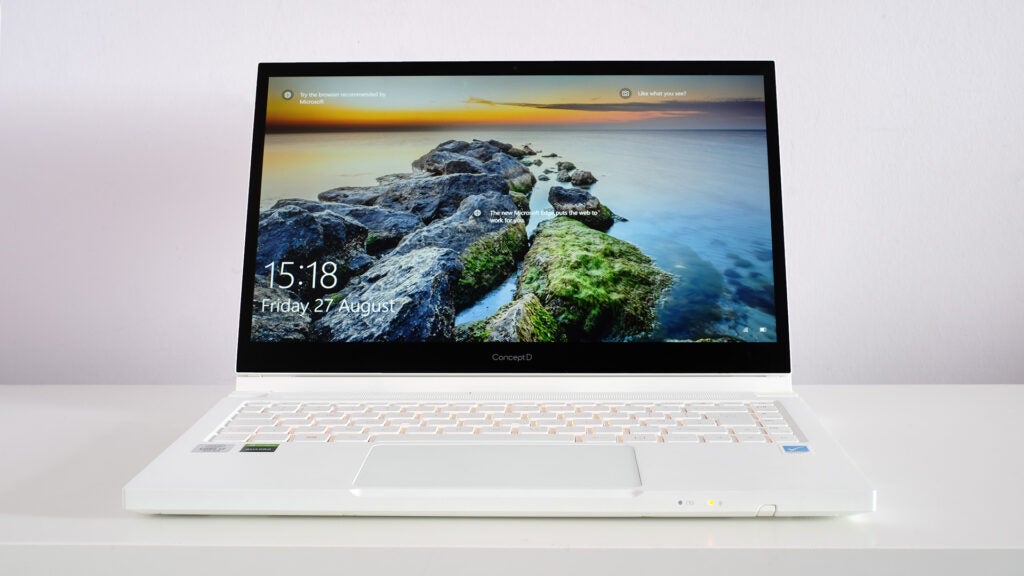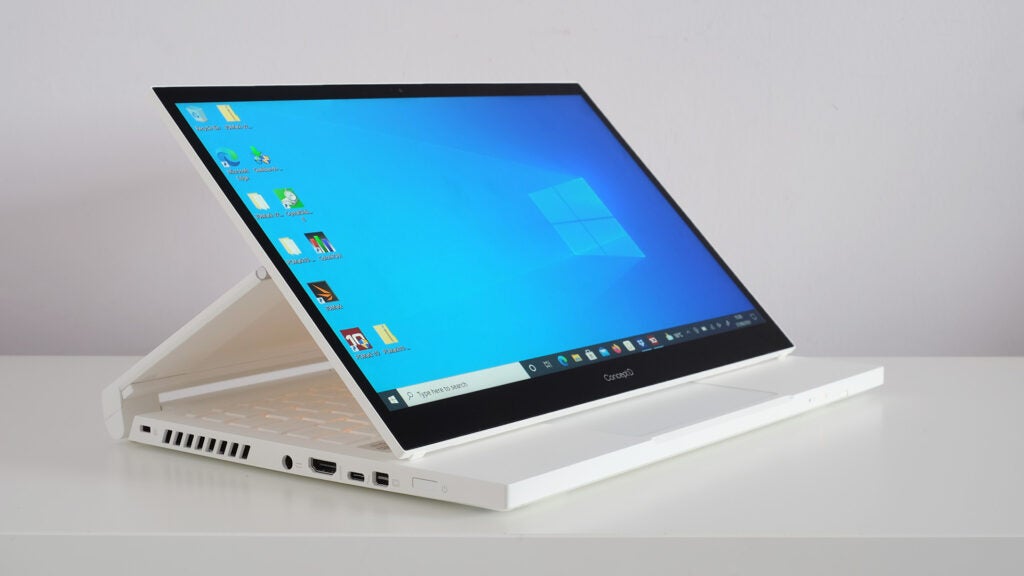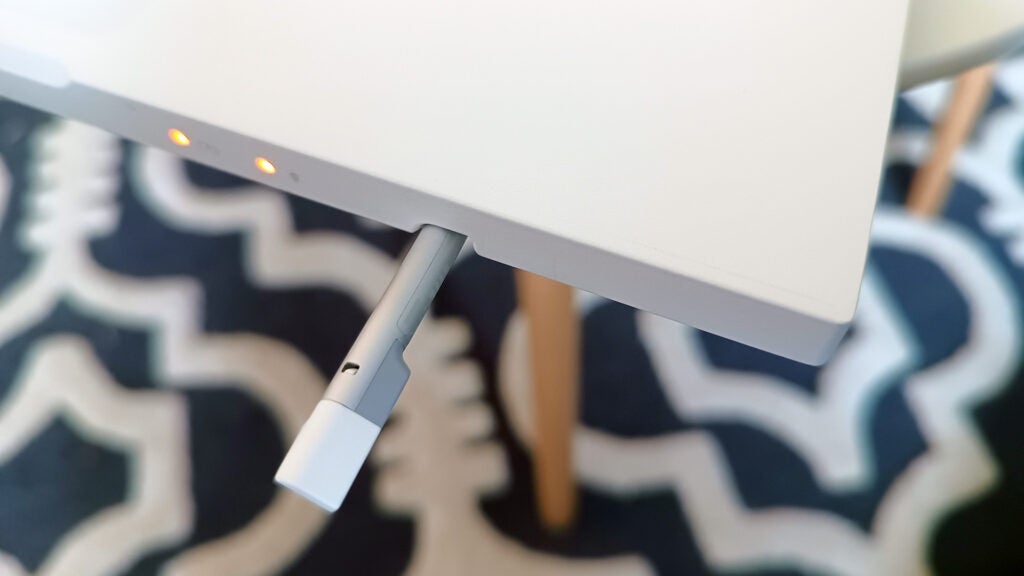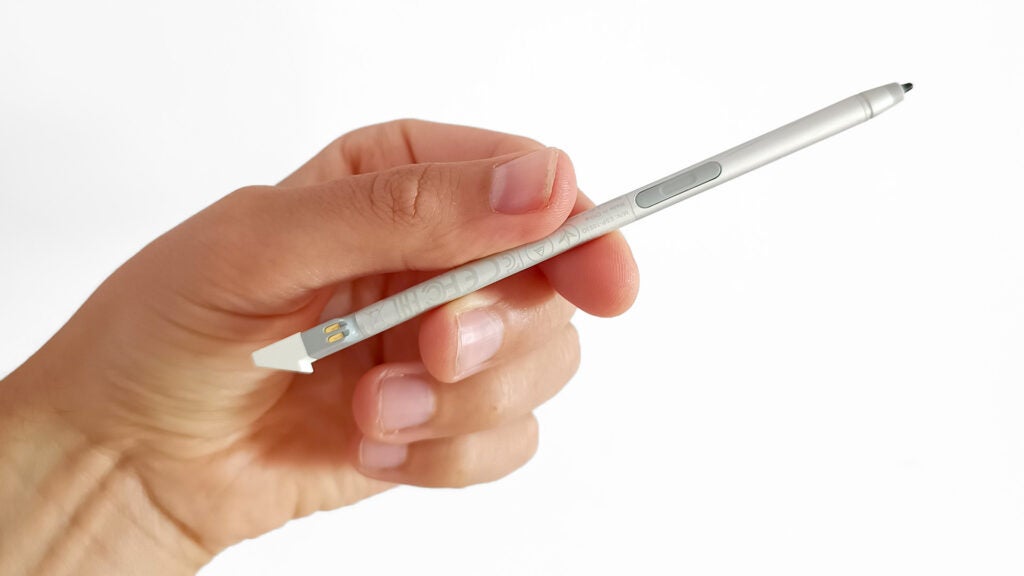Acer ConceptD 3 Ezel Pro Review
A laptop with an unusual screen hinge


Verdict
The Acer ConceptD 3 Ezel Pro is an Nvidia Quadro GPU version of Acer’s dual-hinge display design and content creation laptop. While it may not have the resolution and power some “pros” need, it’s a mostly elegant take on the concept that can be happily used as a home workstation for other jobs.
Pros
- Deep-action keyboard
- Quality glass touchpad
- Useful, well-designed two-way hinge
- Slot-in sty
Cons
- Cheaper gaming PCs offer better rendering performance
- Last-generation CPU
- 1080p resolution is arguably low for this type of laptop
Availability
- UKRRP: £1999
Key Features
- Dual-hinge screen designThe laptop’s screen can be pulled out to make it easier to sketch and doodle
- Stylus includedThe bundled stylus features 4096 pressure levels
- Nvidia Quadro GPUThe integrated Quadro GPU has been optimised for content creation workloads
Introduction
The Acer ConceptD 3 Ezel Pro is a laptop for designers. It has an Nvidia Quadro graphics card, a Pantone validated screen and – most important of the lot – a dual-axis display hinge that lets the screen articulate at angles that aren’t possible with other laptops.
While I don’t think this is necessarily a must-have replacement for a Wacom Cintiq series hooked up to a conventional PC, Acer has done a good job with the Acer ConceptD 3 Ezel Pro.
The screen hinge is sturdy, and it’s enjoybale to work on more generally thanks to a satisfying keybaord and quality touchpad.
Price and availability
The Acer ConceptD 3 Ezel Pro costs £2000 in the spec reviewed. That gets you a 14-inch screen, 1TB SDD, 16GB of RAM and a 10th-Gen Intel Core i7-10750H CPU.
There’s also a 15.6-inch version for around £200 more, and a “non Pro” model with an Nvidia GTX 1650 GPU for around £200 less.
For a greater wealth of options, check out the Ezel 7 series. It’s available with much higher-end GPUs and a greater screen resolution and colour depth.

Design
- Ceramic-hardened finish
- Dual-hinged lid
- Semi-portable design
The Acer ConceptD 3 Ezel Pro is an extremely white laptop. It’s a reminder of the days that white computers were a designer’s staple, because iMacs and MacBooks were white.
They aren’t anymore, but a white shell in 2021 gives the Acer ConceptD 3 Ezel Pro an unusual appearance. This isn’t a cheap finish, either. The Acer ConceptD 3 Ezel Pro has an aluminium shell, and the white is a ceramic coating.
Its hinge is the standout feature, though. You can push the screen back to almost 180 degrees, but there’s a secondary pivot around half-way up the display. This lets you pull the Acer ConceptD 3 Ezel Pro screen closer to you, so it’s held in place but hovers over the keyboard.

I recall trying some Acer laptops with a similar hinge design around a decade ago, when convertibles were the new hot thing. But nowhere does it make more sense than in a “designer’s” laptop such as this.
It’s a well-implmeneted hinge, because there’s enough resistance to the secondary pivot point to let you draw on the screen without it moving under the pressure. In a dream laptop scenario, we might have the option to lock the Acer ConceptD 3 Ezel Pro in a specific position. But thinking about how you’d do this without risking someone overtightening it and breaking it is enough to make me wish I never brought the idea up.
Also, as long you rest the bottom of the screen on some part of the keyboard plate, rather than leaving it hovering, the Acer ConceptD 3 Ezel Pro feels solid and secure.

The laptop weighs 1.78kg according to my scales and is 23mm thick. It isn’t an ultraportable, but that hinge was always going to add some weight.
Its keyboard is great, with a much deeper action than almost all laptops I’ve reviewed in the past 12 months. Acer says the keys have 1.55mm depth –better than the 1.4mm that was once the default, but which is now a rare treat for those who like substantial-feeling keys.
Typing is fast and comfortable, with less pronounced resistance than you get in some deep-dish business laptops. It isn’t my favourite keyboard of the past 12 months, but I like it a lot.

It has an orange backlight, a respite from all the white – but a white LED backlight would have looked classier. The unusual hinge makes this laptop stand out enough already.
The Acer ConceptD 3 Ezel Pro’s touchpad is great, too. It uses textured Gorilla Glass for its surface, which feels smooth and non-tacky. It’s of a good size, too.
Is it as good as a MacBook Pro 16 or Surface Laptop 3? Not quite. There’s a certain clacky quality to the clicker if you press it towards the bottom, and it could perhaps be a bit easier/faster to depress for Photoshop work. But for general use, it’s strong.

Display and stylus
- Slot-in stylus with 4096 pressure levels
- Full HD IPS LCD screen
- Gorilla Glass display covering
The Acer ConceptD 3 Ezel Pro has a 1080p 14-inch screen. It has a textured Corning Gorilla Glass top layer, one that busts reflections and alters how the stylus feels as you glide the nib across its surface. I couldn’t ask for a better screen surface.
The Acer ConceptD 3 Ezel Pro’s stylus slots into the front of the laptop. It’s a metal-barreled unit that uses Wacom tech to provide 4096 levels of pressure sensitivity. While Wacom graphics tablets offer more, such an increase just isn’t going to be noticeable in most use cases anyway.

This stylus houses a little battery for power, but it recharges automatically on being put back in its slot. Palm rejection – stopping the capacitive touchscreen registering presses when using the stylus – works very well. And while the feel of the hard plastic nib on the Gorilla Glass screen is nothing like using pencil on paper, the etched glass is certainly better than standard slick glass.
I do wonder whether designers would want to use the Acer ConceptD 3 Ezel Pro’s Active Stylus all day, though. The barrel is narrow, just like every stylus that slots into a tablet or laptop. If you’re going to spend hours holding the pen, you’ll probably want something closer to a standard Wacom Intuos pen.
Neither do we get the best kind of stylus tech here. It uses AES rather than EMR; equivalent to the budget Bamboo line rather than the Intuos/Cintiq tablets. This is the reason the pen requires its own power. I’m no professional artist/designer, but I haven’t noticed any major issues with line accuracy, and only slight line-trailing is evident when performing fast strokes.
If you want a portable accompainment to a home/office graphics tablet, it could be just right.

The actual IPS LCD panel is solid, but is sure to disappoint some in a few areas. Its peak brightness is 379 nits according to my colorimeter, which is reasonably close to the 400-nit claim. Contrast of 1415:1 is good for an IPS LCD, and is appreciable in the picture’s punchiness, even in normal lighting.
Colour and resolution are the potential stumbling blocks. The Acer ConceptD 3 Ezel Pro covers 99.2% of the sRGB colour gamut, but only 72.6% of Adobe RGB and and 77.2% of DCI-P3. If you work in sRGB, there’s no problem. But if you need full or near-full coverage of one of the wider gamuts then you’re out of luck. Check out the Ezel 7 series instead.
I see this sort of colour depth in plenty of “normal” premium laptops.
The maximum Delta E, which measures colour accuracy, is decent at 1.4. But I use a fairly humble Spyder X Pro colorimeter, not an ultra-high-end Klein model, so this figure may not be 100% accurate. It is within Acer’s own claims of a Delta E of below 2, however.

Resolution is the reason the Acer ConceptD 3 Ezel Pro doesn’t exactly bowl you over at first look. It’s a 1920 x 1080 pixel screen, resulting in fairly obvious pixellation at 14 inches.
My ideal resolution here probably wouldn’t be 4K, which always brings with it a significant hit to the battery. But 2560 x 1440, or a 16:10 aspect 2560 x 1600 panel, would offer a good middle-ground between power drain and visible pixel reduction. You’re probably going to get pretty close to this screen, and will need to accept a certain level of visible pixel structure.
Performance
- Nvidia Quadro T1000 graphics
- 10th-Gen Intel Core i7 CPU isn’t the latest
- Effective, if occasionally distracting, cooling system
The Acer ConceptD 3 Ezel Pro is a performance laptop, and it’s a shame we’ve only managed to get it in for review in the latter half of 2021 because its processor is already out of date. It includes the 10th-Gen Intel Core i7-10750H. Laptops with the 11th-Gen Core i7-11800H are already out on the market .
However, this doesn’t rule out the Acer ConceptD 3 Ezel Pro, since many of those laptops are gaming models that would be unsuitable for the work for which this Acer is made.
It’s a 6-core, 12-thread CPU, part of Intel’s H series. This is the kind of laptop processor you want for extended periods of strain, when rendering 3D projects or running continuously demanding apps.
The Acer ConceptD 3 Ezel Pro also has an Nvidia Quadro T1000 Max-Q graphics card. It’s from Nvidia’s pro line, with performance and drivers made for industry standard apps rather than games. Its benchmark scores are somewhat comparable to those of an Nvidia GTX 1650 graphics card.

I’m somewhat suspicious about the use of lower-end Quadro graphics cards such as the T1000. Sure, the higher-end Quadros are awesome for professionals who need to use specific CAD applications, but does the Quadro T1000 really offer that much of a boost over a consumer-grade card? After all, it doesn’t have the ultra-high memory bandwidth of a top-tier Quadro.
I ran a test I don’t normally subject laptops to: SPECviewperf. It emulates moving around 3D CAD objects, and I tried its SolidWorks module. The Acer ConceptD 3 Ezel Pro scored 73.29. Lenovo’s Legion 5 Pro scored 224.16. A higher score is better.
You could argue this isn’t that fair a test given that the Lenovo features a graphics card – the RTX 3070 – from several tiers up. But you can buy this laptop for £700 less, and it destroys the Acer in tests that should specifically bring out the skills of a Quadro card.

I tried SPECviewperf’s Catia module, too, which emulates another of the big CAD software packages. The difference is less marked this time, with the Acer scoring 31.98 to the Lenovo’s 61.09.
This reveals the Acer ConceptD 3 Ezel Pro for what it is – a lifestyle-leaning content creation laptop that just happens to have a “Pro” graphics card that isn’t actually all that powerful. It just punches above its weight for CAD applications in its class, which is an entry-level or lower-mid-range one.
Is it powerful enough? Probably. Certainly for hobbyists. But I can’t help but think that most buyers would get better value out of a consumer-grade card at this level. Acer does sell a non-pro version of this laptop for £200 less, but it only has the GeForce GTX 1650. You don’t get the performance-per-pound value of a top gaming laptop.
You have to accept that with the Acer ConceptD 3 Ezel Pro you’re paying a good chunk for the ceramic-coated shell, etched glass screen and specialist display hinge, for example.
I’m not a huge fan of the cooling system – but for a fairly thin reason. It appears to deal with heat just fine, but noise is quite noticeable. One of the fans has a high-pitch, high-rpm character that’s less easy to ignore than some. Still, I don’t think it’s a reason to be turned off the Acer ConceptD 3 Ezel Pro.
Battery life
- All-day battery life for light work
- 135W charger
- Wide array of connection types
The Acer ConceptD 3 Ezel Pro’s battery life earns it back some buyer’s recommendation kudos. It lasts for 10hrs 30mins of the PCMark 10 Modern Office battery life benchmark at 150-nit screen brightness.
That’s a great result for a laptop with an H-series CPU and a dedicated Nvidia graphics card.
The Acer ConceptD 3 Ezel Pro uses a cylindrical charger plug, and a mid-size 135W power supply brick.


Its connection array is excellent, as long as you’re fine with having only one USB-C port, which supports Thunderbolt 3.0 rather than Thunderbolt 4.0.
Acer makes up for this with a bunch of other connector types: HDMI, mini-DisplayPort, a full-size SD card slot and two USB-As of the 3.2 Gen 2 variety.
Final points of note: the webcam is poor and the stereo speakers have zero bass, sound small and aren’t particularly loud. A little more attention here probably wouldn’t have gone to waste, given the Acer ConceptD 3 Ezel Pro might also be a good fit for motion artists.
Latest deals
Should you buy it?
You want and all-purpose laptop and content creation station:
This is a specialist laptop but one key strength is its ability to transform from a ‘normal’ computer into a drawing and design tool just by popping out the stylus and twisting the two-way hinge.
You need blistering pro workstation power:
If you mostly care about rendering power then you’re probably better off with a cheaper gaming PC with an Nvidia RTX 3070/3080 graphics card. The ConceptD Ezel 3 Pro also uses a last-generation CPU.
Final Thoughts
The Acer ConceptD 3 Ezel Pro is an interesting laptop for digital artists and designers looking for a screen that seems made for them. It has a matte glass surface and a two-way hinge that allows for much more dynamic articulation than other hybrid laptops.
Don’t buy one expecting pro workstation-grade performance, however, since the Nvidia Quadro T1000 isn’t that high-end a card. But given how ridiculously expensive those high-end Quadro laptops are, the Acer ConceptD 3 Ezel Pro is still a good option.
How we test
Every laptop we review goes through a series of uniform checks designed to gauge key things including build quality, performance, screen quality and battery life.
Used as our main laptop for the review period
Tested for at least a week
Used consistent benchmarks for fair comparisons with other laptops
Tested the battery with a benchmark test
FAQs
This laptop has an Acer stylus, but it uses Wacom AES tech in the screen to provide pressure sensitivity.
Yes, but it depends on your performance demands, as the Quadro T1000 isn’t a top-tier GPU.
Like most recent stylus-equipped tablets, there are 4096 levels of pressure sensitivity available here.








